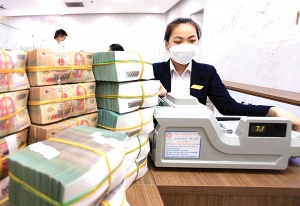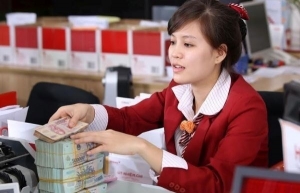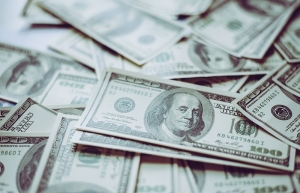Softer exchange rate loom in H2
In the global market, the greenback is forecast to continue to weaken. Accordingly, the US Federal Reserve raised the base rate by a quarter of a percentage point in the early May meeting, but many forecasts believe that this might be the last base rate hike before it trends sideways, and that it is likely that the Fed will start cutting the rate in the second half of this year.
Accordingly, the SBV reduced the diverse regulatory rate by 0.5 per cent from May 25.
 |
Commenting on the impact of the rate change, Nguyen Hung, CEO of tech-driven TPBank, said that although it might go counter to the world trends, there were positive signs supporting the move, such as the Fed or several central banks might stop adjusting interest rates, and the local economy had acquired enough resources to control the situation.
“Many banks can now take the initiative of their forex reserve. As people and businesses are grappling with a myriad of difficulties, lowering the interest rate proves a necessity,” said Hung.
Dinh Duc Quang, cash management executive director at UOB Vietnam, noted that the VND was one of the most resilient currencies in Asia.
"Despite concerns over possible global economic recession as well as US banking system’s frustrating situation, the VND currency is traded in a tight range +/- 0.8 per cent around regulated VND23,600 per dollar," Quang said.
| The favourable factors attributable to the USD/VND exchange rate downward trend are a possible trade rebound in the second half, continued stable forex supply coming from FDI disbursement into the stock market, among others. |
Other positive factors are that the SBV cut the refinancing rate by 100 basic points on March 16, and a rebound of export and industrial production in the upcoming months paired with abated inflation, which will keep the VND stable.
“Generally, we expect the exchange rate of USD/VND pair to be fluctuating in the orbit similar to that of the USD versus other Asian currencies, meaning it might go up slightly in Q2 before being softened in Q3 of this year. Our forecast is that the exchange rate fetches VND23,800 in the final quarter of this year, and pulls down to VND23,600 per dollar early next year,” said Quang.
A leader at state lender BIDV said that the forex supply would hit a surplus approximating $1 billion in May and the improved supply-demand situation would provide a solid buffer to the exchange rate in the domestic market and help the central bank acquire additional resources to ameliorate forex reserves.
The USD/VND rate in the interbank market has witnessed big fluctuations since late last year. After escalating in September and October, the exchange rate pulled back fairly strongly before being stabilised, centering around the regulated reference buying price of the SBV at VND23,450 by the end of Q1.
In early Q2, this exchange rate shows signs of going up slightly, attuned to the upward trend of the USD in the global market.
The favourable factors attributable to the USD/VND exchange rate downward trend are a possible trade rebound in the second half, continued stable forex supply coming from FDI disbursement into the stock market; as well as the capital flow coming from inward remittances and tourism sector.
HSBC has forecast that the SBV’s dollar reference buying price would serve as a harbinger for the USD/VND exchange rate trend in the months to come, and it might further soften the rate if supportive factors continue.
The SBV had previously lowered the buying price from VND23,450 to VND23,400 per dollar, the first time it changed the buying price since December 2022. This might signify the first signals of a new trend in the USD/VND exchange rate.
“However, on the opposite site, as there are many uncertainties in the global economy and several scenarios persist regarding the future policy stance of the Fed, we are cautious upon the general trend of the USD versus other currencies in the international market, which might affect the exchange rate situation in the domestic market going forward,” said HSBC.
 | Exchange rate spike not deemed an imminent threat The USD exchange rate on the morning of February 24 on the free market and banks both increased sharply compared to the previous session, exceeding the threshold of VND24,000. |
 | New exchange rate policy not without risk Exchange rate volatility is increasing due to geopolitical shocks across the globe. Thanks to its sound policy framework, Vietnam has remained largely immune to such international turbulence. However, exchange-rate depreciation is not without risks, writes Patrick Lenain, senior associate at the Council on Economic Policies. |
 | Reference exchange rate down 18 VND The State Bank of Vietnam set the daily reference exchange rate for the US dollar at 23,263 VND/USD on September 9, down 18 VND from the previous day. |
 | Inflation risks pose questions for exchange rate policy In response to the recent Fed’s interest rate hike, the State Bank of Vietnam is predicted to tighten its monetary policy in an attempt to curb inflation, with a focus on controlling the exchange rate. |
What the stars mean:
★ Poor ★ ★ Promising ★★★ Good ★★★★ Very good ★★★★★ Exceptional
Related Contents
Latest News
More News
- Banks gear up for massive capital increases (December 18, 2025 | 17:04)
- Securing capital and efficiency for Vietnam’s 2026-2030 growth ambitions (December 17, 2025 | 10:00)
- Energy sector in need of blended finance mechanisms (December 17, 2025 | 09:00)
- Vietnam still has room to mobilise capital for sustainable growth (December 17, 2025 | 08:57)
- Long-term capital seen as key hurdle to green growth (December 16, 2025 | 08:00)
- Gold prices swing amid tax debate and import uncertainty (December 15, 2025 | 18:04)
- Agribank frames bank credit as catalyst for green growth (December 15, 2025 | 17:59)
- Vietnam’s green transition demands collective financial action (December 15, 2025 | 12:00)
- VIR workshop highlights capital and policy for sustainable development (December 15, 2025 | 11:00)
- Promoting digital assets initiative in Vietnam (December 13, 2025 | 09:30)

 Tag:
Tag:



























 Mobile Version
Mobile Version